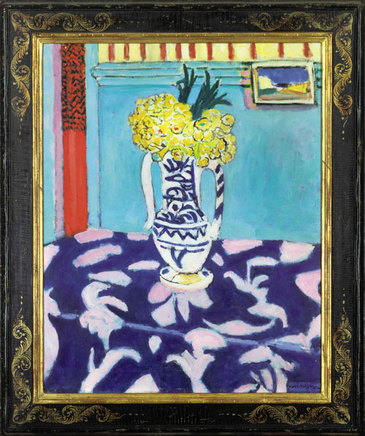 Tired of the economic slump we artists have been enduring, any good news concerning the art market is encouraging and worthwhile to pass along to my fellow artists and art enthusiasts. This week, CNBC announced on their blog, Alternative Investing:“Investing in Art Can Mean Pretty Profits.”
Tired of the economic slump we artists have been enduring, any good news concerning the art market is encouraging and worthwhile to pass along to my fellow artists and art enthusiasts. This week, CNBC announced on their blog, Alternative Investing:“Investing in Art Can Mean Pretty Profits.”
In the image on the left, Henri Matisse’s “Les coucous, tapis bleu et rose” (1911) sold for $46,457,480 at Christie’s and was record-shattering.
Please read on even though this article primarily pertains to ‘investment art’ as an alternative to stocks, but this is good news as beginning investors look to lesser known artists….more below…
For the purpose of this article, fine art includes paintings, sculpture, prints, video and photography.
CNBC Reports: “Indeed, for over the ten-years ended July 2010, the price index of all fine art work sold more than once worldwide has produced a nearly 11 percent annualized return, outperforming the Standard & Poor’s 500 index of large cap stocks and most other asset classes, including bonds and commodities…”
According to Artprice, some 70 percent of all artwork sold at auction between January 2008 and June 2009 was priced at $5,000 or less. During that same period, “affordable” art priced below $5,000 gained 60 percent in value, while higher end pieces gained a staggering 150 percent.
- CNBC reports that according to Daniel Komala, CEO of Larasati Auctioneers, this is the best time to buy fine art as prices are very close to rock bottom.
- Al Brenner of MutualArt.com states that after art prices dropped dramatically, art prices have climbed back up to about 2006 levels. On average, prices of works will go up. (Of course this is good news!)
Here are a few points to keep in mind while considering investing in art or photography:
- If you even think about putting down money, however, it’s important to educate yourself on the forces effecting the art market overall, and the niche you’re hoping to pursue.
- There are steps you can take to mitigate risk and boost your profit potential — and you don’t have to be a Rockefeller to buy art!
- Art investment advisor Brenner: “You can start investing in art with lesser known artists.” <<< more good news!
- Art is far less liquid than other financial assets, making it harder to sell in a pinch.
- Art is a volatile asset. It’s hard to tell when demand for a certain genre will suddenly surge or dry up.
- From a return on investment standpoint, he says, it’s also good advice to buy the best piece you can afford.
- The great photographs now are expensive, but generally increase in value the most. Mediocre objects tend not to increase in value at the same pace.
- Blue Chip art (e.g. Monet, Chagall, Giacometti, Degas, Warhol) usually holds its value.
- Judge art with a balance of monetary value and a value of enjoyment.
- Be sure, too, to buy what you like. That way, if your twentieth-century still-life painting fails to appreciate in value, you can still appreciate its contribution to your wall.
Please check out the full CNBC report about investing in the art market here: http://www.cnbc.com/id/39386118/
*****
PS. BTW, I’ve got some great paintings for sale…hint, hint 😉 ~Lori
If you liked this article, you might also enjoy reading:
How to Bring Out the ‘Mona Lisa’ in Your Own Artwork
Create A Niche Market for Your Art in a Sea of Artists
10 Ways to Market Art and Develop Your Brand
3 Tips for Artists to Promote Themselves and Their Galleries







